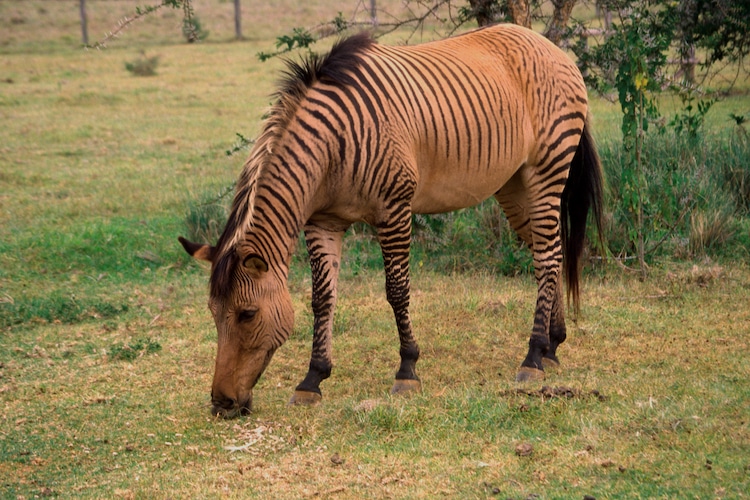Ever wondered what would happen if a zebra and a horse had a baby? Meet the zorse—a rare and fascinating hybrid that combines the wild stripes of a zebra with the domestic build of a horse. While you’re unlikely to find a zorse grazing in your local pasture, this crossbreed has captured the curiosity of scientists and animal lovers alike.
In this article, we’ll dive into everything you need to know about zorses, including how they’re bred, what they look like, how they behave, and some truly fun facts that might surprise you!
What Is a Zorse?
A zorse is the offspring of a male zebra (stallion) and a female horse (mare). This hybrid animal is a type of “zebroid,” a category that includes all zebra hybrids, such as zonkeys (zebra + donkey) and zebrinnies (zebra + pony).
Zorses are not naturally found in the wild. They are usually bred in captivity for novelty, scientific research, or conservation awareness programs. Because zebras and horses belong to the same genus, Equus, they can interbreed—but the result is usually a sterile animal.
What Do Zorses Look Like?
Zorses are known for their striking and unique appearance. Their looks can vary, but here are some common characteristics:
- They usually have a horse-like body with the distinctive stripes of a zebra.
- Stripes may appear on the legs, neck, rear, or even all over the body.
- Their coat color often reflects the horse parent—so you might see chestnut, bay, or black zorses with striped overlays.
- They typically have a shorter mane and a more muscular build than horses.
The result is a beautiful and exotic-looking animal that looks like it stepped right out of a fantasy book!
Are Zorses Sterile?
Yes, like most animal hybrids, zorses are generally sterile. This happens because horses have 64 chromosomes, while zebras have between 32 and 46 (depending on the species). The offspring ends up with an uneven number of chromosomes, which typically makes reproduction impossible.
So while zorses can be bred from a zebra and horse, they usually can’t produce babies of their own.
Behavior and Temperament
Zorses are intelligent and strong—but they’re also known to be a bit more temperamental than horses. That’s because they inherit some of the wild instincts of their zebra parent.
- They may be more cautious or skittish around people.
- They can be harder to train than a typical horse.
- They are often more aggressive or territorial than domestic horses.
- However, when handled from a young age, zorses can be trained and used for riding or trekking.
Many people describe zorses as having the strength and endurance of a zebra with the manageability of a horse—if trained properly.
Fun Facts About Zorses
- Each zorse’s pattern is unique—just like a zebra’s fingerprint!
- Zorses have been featured in fiction and film, including “The Wizard of Oz” (yes, those striped horses were dyed, but the idea was inspired by real hybrids).
- They’re often used in awareness campaigns about hybridization and wildlife conservation.
- Zorses are stronger than horses of similar size, making them excellent pack animals in rough terrain—though their temperament makes them a challenge.
- They are not considered a separate species, but rather a hybrid—a fascinating example of how genetics works between close relatives in the animal kingdom.
Where Can You Find Zorses?
You won’t find zorses in the wild, but some zoos, wildlife parks, and conservation centers around the world have them on display. Some private breeders and exotic animal farms also breed zorses, but they are relatively rare.
They are more common in countries where exotic animal breeding is legal and regulated, such as parts of the United States, South Africa, and the U.K.
Is It Ethical to Breed Zorses?
That’s a big question—and opinions vary. Some animal welfare groups question the ethics of breeding hybrids for novelty or entertainment. Since zorses are usually sterile and sometimes have health issues due to genetic mismatch, critics argue it’s unfair to bring them into existence without purpose.
However, others argue that zorses serve an educational purpose, helping people understand biodiversity, conservation, and the limitations of interspecies breeding.
As with all exotic or hybrid animals, the key is ensuring they are bred responsibly and cared for humanely.
Can You Ride a Zorse?
Yes, but it’s not for beginners! Zorses are strong and capable of carrying riders, but their wild side makes them less predictable. They require experienced handlers and trainers to be safe and manageable under saddle.
Some zorses have been used in trekking or farm work, especially in rugged environments where their strength and stamina shine. But they are generally not as docile or cooperative as your average riding horse.
Why Zorses Fascinate Us
The zorse is a living example of how nature, science, and curiosity can intersect. With the striping of a zebra and the form of a horse, this hybrid animal turns heads and sparks questions everywhere it goes.
Whether you’re an animal lover, a biology enthusiast, or just someone who loves fun facts, the zorse is proof that the animal kingdom is full of surprises. While not common or particularly practical, these hybrid animals open up conversations about genetics, domestication, and the ethical boundaries of breeding.
So, next time you see a zebra or a horse, just imagine what happens when you combine the two and you’ll have a zorse in mind!


